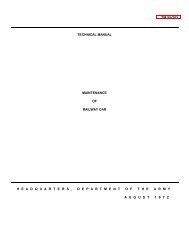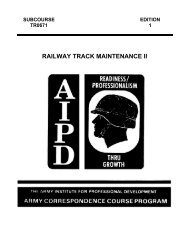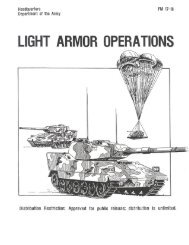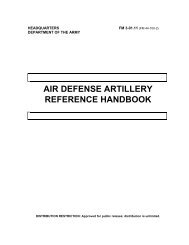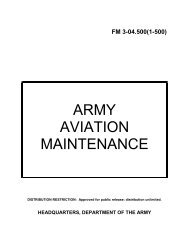fm 44-100 us army air and missile defense operations
fm 44-100 us army air and missile defense operations
fm 44-100 us army air and missile defense operations
You also want an ePaper? Increase the reach of your titles
YUMPU automatically turns print PDFs into web optimized ePapers that Google loves.
FM <strong>44</strong>-<strong>100</strong><br />
Employment of Active Air Defense<br />
3-61. Early warning of enemy <strong>air</strong> attack is vital if early engagement <strong>and</strong><br />
<strong>defense</strong> in depth are to be achieved. Active <strong>air</strong> <strong>defense</strong> is developed to permit<br />
the interception of intruding threat <strong>air</strong>craft as early as possible <strong>and</strong> as far<br />
forward as feasible. Engagement should continue through weapons release,<br />
departure from the target area, <strong>and</strong> return to base. Firing doctrine should<br />
address the allocation of available weapons to inbound threats before any<br />
allocation to outbound <strong>air</strong>craft. The following paragraphs address how<br />
weapon systems may be employed.<br />
3-14<br />
3-62. Fighter-interceptor. Fighter <strong>air</strong>craft may fly three basic missions:<br />
• Interception. Intercept missions may involve the scramble of<br />
<strong>air</strong>craft from ground alert stat<strong>us</strong>, redirection of <strong>air</strong>craft from combat<br />
<strong>air</strong> patrols, or redirection of <strong>air</strong>craft from other type missions.<br />
• Combat <strong>air</strong> patrol (CAP). These missions enable rapid reaction to<br />
threat intr<strong>us</strong>ion <strong>and</strong> may be positioned well forward of areas to be<br />
defended, over a specific area, in support of friendly <strong>air</strong> or surface<br />
forces, over critical areas of a combat zone, or over <strong>air</strong>, l<strong>and</strong>, <strong>and</strong> sea<br />
corridors.<br />
• Air escort. Air escort missions in support of other <strong>air</strong>craft.<br />
Unescorted <strong>air</strong>craft normally carry self-<strong>defense</strong> weapons.<br />
3-63. Armed Helicopters. Aerial combat is an integral part of the ground<br />
comm<strong>and</strong>er's scheme of maneuver <strong>and</strong> may be controlled by either the<br />
aviation or ground maneuver force comm<strong>and</strong>er. Although it is a self-<strong>defense</strong><br />
mission, <strong>air</strong> combat can occur during both offensive <strong>and</strong> defensive <strong>operations</strong>.<br />
Air combat is inherent in aviation's maneuver role in the reconnaissance <strong>and</strong><br />
security, attack, <strong>and</strong> <strong>air</strong> assault missions <strong>and</strong> m<strong>us</strong>t be linked to the aviation<br />
comm<strong>and</strong> <strong>and</strong> control system.<br />
3-64. Surface-to-Air Weapons. Surface-to-<strong>air</strong> weapons are employed to<br />
protect the force. These weapons offer large amounts of firepower <strong>and</strong> instant<br />
responsiveness. For maximum effect, a mix of types of surface-to-<strong>air</strong> weapons<br />
should be employed in an integrated <strong>air</strong> <strong>defense</strong> since the optimal capabilities<br />
of each weapon system occur at different ranges <strong>and</strong> altitudes. Surface-to-<strong>air</strong><br />
systems provide the best overall coverage when their <strong>operations</strong> are both<br />
integrated <strong>and</strong> coordinated. Integration <strong>and</strong> coordination ensures both a<br />
minimum-risk passage for friendly <strong>air</strong>craft <strong>and</strong> a means to deconflict<br />
employment of surface-to-<strong>air</strong> weapons <strong>and</strong> fighters.<br />
PASSIVE DEFENSE OPERATIONS<br />
3-65. Passive <strong>defense</strong> is all measures, other than active <strong>defense</strong>, taken to<br />
minimize the effectiveness of hostile <strong>air</strong> <strong>and</strong> <strong>missile</strong> threats against friendly<br />
forces <strong>and</strong> assets. Passive <strong>defense</strong> improves survivability by reducing the<br />
likelihood of being detected <strong>and</strong> targeted from the <strong>air</strong> <strong>and</strong> by mitigating the<br />
potential effects of <strong>air</strong> surveillance <strong>and</strong> attack. It includes measures initiated<br />
to reduce vulnerability <strong>and</strong> to minimize the effect of damage ca<strong>us</strong>ed by TM<br />
attack. It does not involve the employment of lethal weapons. Passive <strong>defense</strong><br />
measures by all elements of the joint force are essential to force protection.




